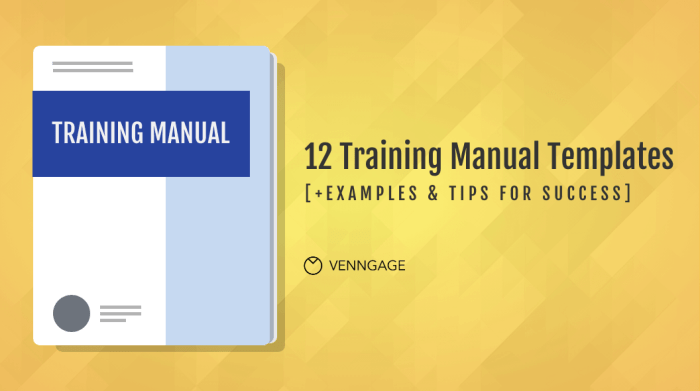
Embark on a journey of creating impactful training manuals with our detailed guide on How to create effective training manuals. From design to content, we’ve got you covered.
Introduction to Training Manuals
Training manuals play a crucial role in educational settings by providing structured guidance and information to learners. These resources are designed to enhance the learning experience and ensure consistency in training delivery.
Examples of Industries
- Manufacturing: Companies in the manufacturing sector often use training manuals to educate employees on safety procedures, equipment operation, and quality standards.
- Retail: Retail businesses utilize training manuals to train staff on customer service protocols, product knowledge, and sales techniques.
- Healthcare: Hospitals and healthcare facilities rely on training manuals to instruct medical staff on patient care protocols, emergency procedures, and compliance regulations.
Role in Enhancing Learning Outcomes
Training manuals are instrumental in enhancing learning outcomes by providing learners with a comprehensive reference guide that they can refer back to. These manuals help to reinforce key concepts, clarify complex information, and standardize training practices across different learners. By offering a structured approach to learning, training manuals can improve retention rates, increase knowledge retention, and boost overall performance in educational settings.
Designing Effective Training Manuals
Creating a well-structured training manual is essential for ensuring that the information is effectively communicated to the trainees. Here are the essential components of a well-structured training manual:
Essential Components of a Well-Structured Training Manual
- Clear Objectives: Clearly Artikel the goals and objectives of the training program.
- Structured Content: Organize the content in a logical sequence for easy comprehension.
- Step-by-Step Instructions: Provide detailed step-by-step instructions to guide trainees through the training process.
- Visual Aids: Include engaging visuals such as diagrams, charts, and graphs to enhance understanding.
- Exercises and Activities: Incorporate interactive exercises and activities to reinforce learning.
- Assessment Tools: Include quizzes or assessments to evaluate the trainees’ understanding of the material.
- Reference Materials: Provide additional resources for further learning or reference.
Comparing Different Formats for Presenting Information
- Text-Based Manuals: Traditional manuals with text-only content.
- Visual Manuals: Manuals that heavily rely on visuals and graphics to convey information.
- Interactive Manuals: Manuals that include interactive elements such as clickable links or multimedia content.
- Combination Manuals: Manuals that combine text, visuals, and interactive features for a comprehensive learning experience.
Tips for Creating Engaging Visuals and Graphics
- Use Color: Incorporate color to make the visuals more appealing and attention-grabbing.
- Simplicity: Keep visuals simple and easy to understand to avoid confusion.
- Consistency: Maintain a consistent design style throughout the manual for a cohesive look.
- Relevance: Ensure that visuals are directly related to the content to enhance comprehension.
- Accessibility: Consider the accessibility of visuals for all trainees, including those with visual impairments.
Writing Clear and Concise Content

When creating training manuals, it is crucial to use simple language and avoid jargon to ensure that the content is easily understood by the readers. This helps in eliminating any confusion and ensures that the information is effectively communicated.
Importance of Using Simple Language and Avoiding Jargon
Simple language makes the content more accessible to a wider audience, including those who may not be familiar with technical terms. Avoiding jargon prevents misunderstandings and ensures that the content is clear and concise.
Strategies for Organizing Content Logically
When organizing content in training manuals, it is essential to follow a logical sequence that flows smoothly from one topic to the next. This can be achieved by outlining the main points and breaking down complex information into smaller, more manageable sections.
- Use headings and subheadings to clearly delineate different sections of the manual.
- Employ bullet points or numbered lists to highlight key points and steps.
- Include relevant examples or case studies to illustrate concepts and make them more relatable.
Techniques for Writing Effective Step-by-Step Procedures
Writing step-by-step procedures in training manuals requires a clear and structured approach to ensure that readers can easily follow the instructions. Here are some techniques to enhance the effectiveness of step-by-step procedures:
- Start each step with a clear action verb to indicate what needs to be done.
- Use a consistent format for all steps to maintain clarity and coherence.
- Include screenshots or diagrams where necessary to provide visual aids for complex processes.
- Review and revise the steps to eliminate any ambiguities or redundancies.
Incorporating Interactive Elements
Interactive elements play a crucial role in enhancing the effectiveness of training manuals by promoting engagement, improving retention, and providing hands-on learning experiences for the trainees. Including elements like quizzes or exercises can make the training process more interactive and enjoyable for the learners, leading to better understanding and application of the material.
Benefits of Interactive Elements
- Enhances engagement and participation levels among trainees.
- Facilitates active learning and knowledge retention through practical application.
- Provides immediate feedback to learners, helping them assess their understanding.
- Encourages critical thinking and problem-solving skills development.
Making Training Manuals Interactive and Engaging
To make training manuals more interactive and engaging, consider incorporating the following elements:
- Interactive quizzes at the end of each section to reinforce key concepts.
- Case studies or real-world scenarios for practical application of theoretical knowledge.
- Hands-on exercises that require trainees to apply what they have learned.
- Interactive multimedia elements such as videos, infographics, or animations to supplement text-based content.
Role of Multimedia Elements
Multimedia elements play a significant role in enhancing the effectiveness of training manuals by:
- Appealing to different learning styles, such as visual or auditory learners.
- Increasing engagement and interest in the training material.
- Providing clarity and reinforcing key concepts through visual aids.
- Improving information retention and recall through a multi-sensory approach.
Accessibility and Inclusivity in Training Manuals
Creating training manuals that are accessible to diverse learners and inclusive of different learning styles is crucial for ensuring effective learning outcomes. It is important to consider accessibility features for users with disabilities to provide equal opportunities for all individuals.
Designing Accessible Manuals
- Use clear and easy-to-read fonts
- Provide alternative formats for visually impaired individuals, such as braille or audio versions
- Ensure color contrast for readability, especially for those with visual impairments
- Include text descriptions for images for individuals using screen readers
Creating Inclusive Content
- Utilize a variety of learning methods, such as visual, auditory, and kinesthetic approaches
- Offer interactive elements like quizzes, activities, and group discussions to cater to different learning styles
- Provide real-life examples and case studies to make the content relatable to diverse audiences
Importance of Accessibility Features
Ensuring that training manuals are accessible to users with disabilities not only promotes inclusivity but also enhances the overall learning experience for all individuals. By incorporating accessibility features, you can create a more engaging and effective training program that benefits everyone involved.
Revision and Updating of Training Manuals

Regularly updating training manuals is crucial to ensure that the content remains accurate, relevant, and effective in meeting the training objectives. As processes, technologies, or best practices evolve, training manuals need to reflect these changes to provide learners with up-to-date information. Failure to revise and update manuals can lead to confusion, inefficiency, or even misinformation among trainees.
Checklist for Reviewing and Revising Manuals
- Review the content for accuracy and relevance.
- Update any outdated information or procedures.
- Check for consistency in formatting and language use.
- Solicit feedback from trainers or trainees for areas of improvement.
- Ensure that any changes are clearly communicated to all stakeholders.
Strategies for Keeping Manuals Relevant
- Establish a regular schedule for manual reviews and updates, based on the frequency of changes in the subject matter.
- Utilize version control to track modifications and ensure that the most recent version is always accessible.
- Encourage collaboration among subject matter experts, trainers, and instructional designers to incorporate diverse perspectives and expertise.
- Consider integrating digital tools or platforms for easier updates and distribution of training materials.
In conclusion, mastering the art of crafting training manuals is key to ensuring successful learning outcomes. Start implementing these strategies today for a more engaging and effective training experience.
General Inquiries
How important are visuals in training manuals?
Visuals play a crucial role in enhancing understanding and engagement in training manuals. They help break up text and make content more digestible.
What is the significance of updating training manuals regularly?
Regular updates ensure that training manuals reflect the latest information and changes, keeping them relevant and effective.
How can I make my training manuals more interactive?
You can incorporate quizzes, exercises, and multimedia elements to make your training manuals interactive and engaging for learners.






